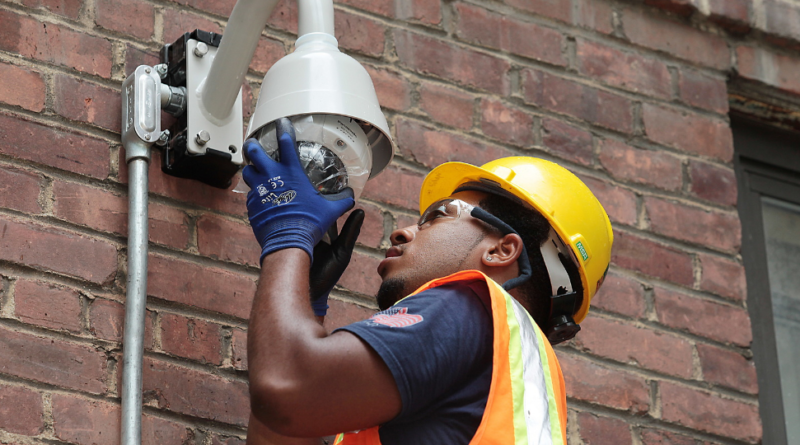NYCHA Completes Over $24 Million in Safety and Security Upgrades at 23 Campuses
On November 27, NYCHA announced the completion of more than $24.1 million in safety and security upgrades, including new CCTV cameras, layered access control installations, entrance renovations, and/or lighting improvements at 23 campuses over the past year to improve the quality of life for over 46,000 NYCHA residents. Developments that received large-scale security improvements include Bailey Avenue-West 193rd Street, Marble Hill, Melrose, Mill Brook, Monroe, and Sedgwick in the Bronx; Farragut, Hughes, Kingsborough, and Pink in Brooklyn; Dyckman, Elliott, Fulton, Grant, King Towers, LaGuardia, LaGuardia Addition, and Rangel in Manhattan; Pomonok in Queens; and Berry in Staten Island. Additionally, the Authority has also completed construction at three developments as part of the Entryways pilot program, which comprehensively renovates building entrances and enhances overall security. These improvements were guided by resident involvement and completed thanks to funding from several current and former City Council members and federal, State, and City funding. Safety and security improvements made at a majority of these NYCHA developments over the last year further Mayor Eric Adams’ Blueprint for Community Safety plan by investing in the rehabilitation of safety and security systems infrastructure at developments within Gun Violence Prevention Task Force priority precincts.
“We appreciate the investment from our partners at the federal, State, and local level who contributed to improving safety and security systems across NYCHA campuses,” said Deputy Mayor for Housing, Economic Development, and Workforce Maria Torres-Springer. “Feeling safe at home is core to well-being, and these improvements demonstrate this administration’s commitment to enhancing living conditions and bolstering that feeling of safety for NYCHA residents.”
“The Authority has made significant improvements to the security infrastructure of NYCHA developments,” said NYCHA CEO Lisa Bova-Hiatt. “These investments in cameras, doors, lighting, and other areas were made possible through support across all levels of government, and we would like to thank the legislators and agencies who marshalled the resources needed to help keep our residents safe. We will continue to prioritize those quality-of-life upgrades that strengthen NYCHA buildings.”
“Safety and security at our developments is paramount to the Authority’s mission of providing quality housing for NYCHA residents,” said NYCHA Chief Asset & Capital Management Officer Shaan Mavani. “We are extremely thankful to our federal, State, and City partners for the funding to be able to make these security upgrades to our buildings, contributing to an invaluable peace of mind for residents in their own homes. We hope residents immediately experience the benefits of these improvements and look forward to completing the additional projects we are currently executing, including the Entryways program, which reimagines the first spaces residents and visitors encounter when entering NYCHA buildings.”
In line with resident priorities, the newly installed closed-circuit cameras (CCTV) were strategically placed at building entrances, roof landings, stairwells, and other exterior and interior areas where illegal activity could occur or where unauthorized entrants could gain access. The CCTV camera installations include LED lighting; a fiber-optic framework for supporting smart building technology; and a security operating center for each installation. The cameras enable remote access and can notify operators when certain units are malfunctioning. The newly installed cameras are operated by the same video management systems as NYPD cameras to allow for variable speed recording and 21-day footage retention.
Additional improved security features were installed at building entrances, such as enhanced exterior lighting, intercom systems, stainless-steel or steel-reinforced aluminum doors and storefronts, and layered access control systems. Layered access control is a resident verification process that controls building entry and allows for the remote ability to change access permissions without having to revoke a physical electronic key fob or change the entry locks and customizes access in the event an entrance is compromised by unauthorized entrants.
Resident involvement is integral to the effective installation of these security technologies, and Section 3 hiring requirements targeting NYCHA residents were mandatory for all installation contracts regardless of the funding source. There were extensive planning phases in which capital project teams conducted walkthroughs with resident leaders, building managers, and staff from the Authority’s Office of Safety & Security (OFSS) to determine optimal camera locations.
NYCHA’s OFSS oversees safety and security matters across all NYCHA properties by ensuring compliance with agency security policies and procedures, administering electronic security access systems, installing and maintaining security hardware, conducting first-line investigations, and scheduling the work of both NYCHA Special Officers and contracted guard services at NYCHA locations. OFSS works closely with the NYPD and provides access to these security systems and CCTV camera footage to facilitate quick and efficient police response to criminal situations.
In May 2020, NYCHA began engaging residents in the design process for another safety and security initiative, the Entryways pilot program, which aims to reimagine entrance points by upgrading intercom systems, enhancing security measures, and alleviating the need to prop open doors. The pilot – which has completed construction at 45 Allen Street, Carver Houses, and Cassidy-Lafayette and started work at Seth Low Houses and Conlon Lihfe Tower – completely modernizes building entrances using layered access systems, steel-reinforced aluminum storefront designs, CCTV cameras, and enhanced lighting. This new entryway standard will also increase maintenance efficiency by reducing the time it takes to repair doors with standardized parts that are readily available instead of custom components with long lead times and high costs.

